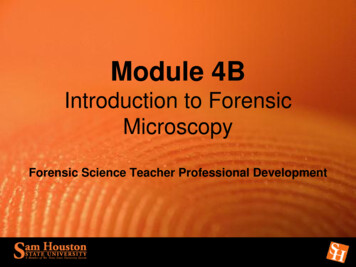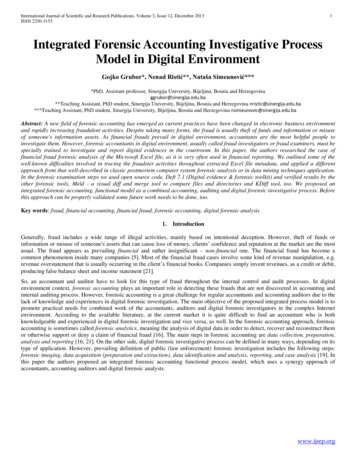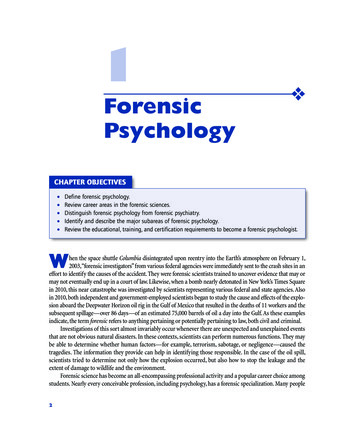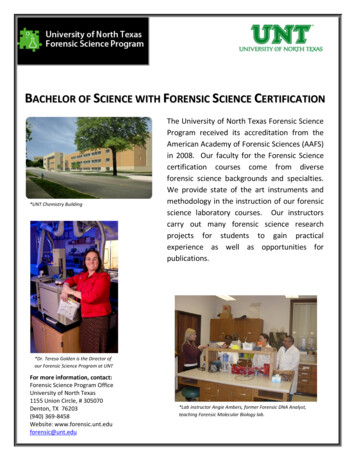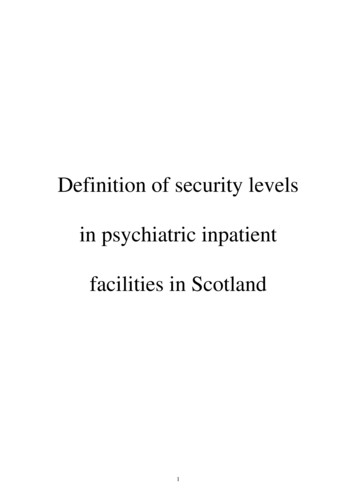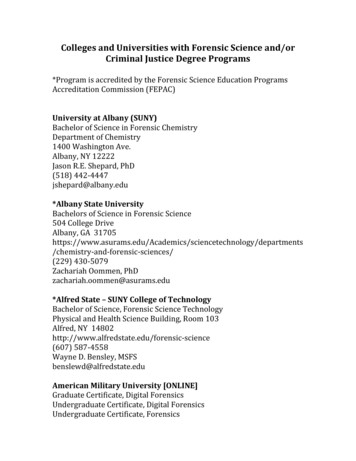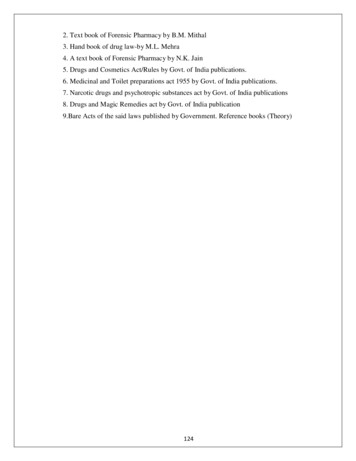
Transcription
2. Text book of Forensic Pharmacy by B.M. Mithal3. Hand book of drug law-by M.L. Mehra4. A text book of Forensic Pharmacy by N.K. Jain5. Drugs and Cosmetics Act/Rules by Govt. of India publications.6. Medicinal and Toilet preparations act 1955 by Govt. of India publications.7. Narcotic drugs and psychotropic substances act by Govt. of India publications8. Drugs and Magic Remedies act by Govt. of India publication9.Bare Acts of the said laws published by Government. Reference books (Theory)124
SEMESTER VI125
BP601T. MEDICINAL CHEMISTRY – III (Theory)45 HoursScope: This subject is designed to impart fundamental knowledge on the structure,chemistry and therapeutic value of drugs. The subject emphasis on modern techniques ofrational drug design like quantitative structure activity relationship (QSAR), Prodrugconcept, combinatorial chemistry and Computer aided drug design (CADD). The subjectalso emphasizes on the chemistry, mechanism of action, metabolism, adverse effects,Structure Activity Relationships (SAR), therapeutic uses and synthesis of importantdrugs.Objectives: Upon completion of the course student shall be able to1. Understand the importance of drug design and different techniques of drugdesign.2. Understand the chemistry of drugs with respect to their biological activity.3. Know the metabolism, adverse effects and therapeutic value of drugs.4. Know the importance of SAR of drugs.Course Content:Study of the development of the following classes of drugs, Classification, mechanism ofaction, uses of drugs mentioned in the course, Structure activity relationship of selectiveclass of drugs as specified in the course and synthesis of drugs superscripted by (*)UNIT – I10 HoursAntibioticsHistorical background, Nomenclature, Stereochemistry, Structure activityrelationship, Chemical degradation classification and important products ofthe following classes.β-Lactam antibiotics: Penicillin, Cepholosporins, β- Lactamase inhibitors,MonobactamsAminoglycosides: Streptomycin, Neomycin, e,Minocycline, DoxycyclineChlortetracycline,UNIT – II10 HoursAntibioticsHistorical background, Nomenclature, Stereochemistry, Structure activityrelationship, Chemical degradation classification and important products ofthe following classes.126
Macrolide: Erythromycin Clarithromycin, Azithromycin.Miscellaneous: Chloramphenicol*, Clindamycin.Prodrugs: Basic concepts and application of prodrugs design.Antimalarials: Etiology of malaria.Quinolines: SAR, Quinine sulphate, Chloroquine*, Amodiaquine,Primaquine phosphate, Pamaquine*, Quinacrine hydrochloride, Mefloquine.Biguanides and dihydro triazines: Cycloguanil pamoate, Proguanil.Miscellaneous: Pyrimethamine, Artesunete, Artemether, Atovoquone.UNIT – III10 HoursAnti-tubercular AgentsSynthetic anti tubercular agents: Isoniozid*, Ethionamide, Ethambutol,Pyrazinamide, Para amino salicylic acid.*Anti tubercular antibiotics: Rifampicin,Streptomycine, Capreomycin sulphate.Rifabutin,CycloserineUrinary tract anti-infective agentsQuinolones: SAR of quinolones, Nalidixic Acid,Norfloxacin, Enoxacin,Ciprofloxacin*, Ofloxacin, Lomefloxacin, s: Furazolidine, Nitrofurantoin*, Methanamine.Antiviral agents:Amantadine hydrochloride, Rimantadine hydrochloride, Idoxuridinetrifluoride, Acyclovir*, Gancyclovir, Zidovudine, Didanosine, Zalcitabine,Lamivudine, Loviride, Delavirding, Ribavirin, Saquinavir, Indinavir,Ritonavir.UNIT – IV08 HoursAntifungal agents:Antifungal antibiotics: Amphotericin-B, Nystatin, Natamycin, Griseofulvin.Synthetic Antifungal agents: Clotrimazole, Econazole, Butoconazole,Oxiconazole Tioconozole, Miconazole*, Ketoconazole, Terconazole,Itraconazole, Fluconazole, Naftifine hydrochloride, Tolnaftate*.Anti-protozoal Agents: Metronidazole*, Tinidazole, Ornidazole, Diloxanide,Iodoquinol, Pentamidine Isethionate, Atovaquone, Eflornithine.Anthelmintics: Diethylcarbamazine citrate*, Thiabendazole, Mebendazole*,Albendazole, Niclosamide, Oxamniquine, Praziquantal, Ivermectin.127
Sulphonamides and SulfonesHistorical development, chemistry, classification and SAR of ethizine,Sulfacetamide*,Sulphapyridine, Sulfamethoxaole*, Sulphadiazine, Mefenide acetate,Sulfasalazine.Folate reductase inhibitors: Trimethoprim*, Cotrimoxazole.Sulfones: Dapsone*.UNIT – V07 HoursIntroduction to Drug DesignVarious approaches used in drug design.Physicochemical parameters used in quantitative structure activityrelationship (QSAR) such as partition coefficient, Hammet’s electronicparameter, Tafts steric parameter and Hansch analysis.Pharmacophore modeling and docking techniques.Combinatorial Chemistry: Concept and applications of combinatorialchemistry: solid phase and solution phase synthesis.128
BP607P. MEDICINAL CHEMISTRY- III (Practical)4 Hours / weekIPreparation of drugs and intermediates1Sulphanilamide27-Hydroxy, 4-methyl coumarin3Chlorobutanol4Triphenyl imidazole5Tolbutamide6HexamineIIAssay of drugs1Isonicotinic acid heniramine maleate6Benzyl penicillinIII Preparation of medicinally important compounds or intermediates by Microwaveirradiation techniqueIV Drawing structures and reactions using chem draw VDetermination of physicochemical properties such as logP, clogP, MR, Molecularweight, Hydrogen bond donors and acceptors for class of drugs course contentusing drug design software Drug likeliness screening (Lipinskies RO5)Recommended Books (Latest Editions)1. Wilson and Giswold’s Organic medicinal and Pharmaceutical Chemistry.2. Foye’s Principles of Medicinal Chemistry.3. Burger’s Medicinal Chemistry, Vol I to IV.4. Introduction to principles of drug design- Smith and Williams.5. Remington’s Pharmaceutical Sciences.6. Martindale’s extra pharmacopoeia.129
7. Organic Chemistry by I.L. Finar, Vol. II.8. The Organic Chemistry of Drug Synthesis by Lednicer, Vol. 1-5.9. Indian Pharmacopoeia.10. Text book of practical organic chemistry- A.I.Vogel.130
BP602 T. PHARMACOLOGY-III (Theory)45 HoursScope: This subject is intended to impart the fundamental knowledge on various aspects(classification, mechanism of action, therapeutic effects, clinical uses, side effects andcontraindications) of drugs acting on respiratory and gastrointestinal system, infectiousdiseases, immuno-pharmacology and inaddition,emphasis on the principles oftoxicology and chronopharmacology.Objectives: Upon completion of this course the student should be able to:1. understand the mechanism of drug action and its relevance in the treatment ofdifferent infectious diseases2. comprehend the principles of toxicology and treatment of various poisoningsand3. appreciate correlation of pharmacology with related medical sciences.Course Content:UNIT-I1. Pharmacology of drugs acting on Respiratory systema.b.c.d.e.10hoursAnti -asthmatic drugsDrugs used in the management of COPDExpectorants and antitussivesNasal decongestantsRespiratory stimulants2. Pharmacology of drugs acting on the Gastrointestinal Tracta. Antiulcer agents.b. Drugs for constipation and diarrhoea.c. Appetite stimulants and suppressants.d. Digestants and carminatives.e. Emetics and anti-emetics.UNIT-II3. Chemotherapya. General principles of chemotherapy.10hoursb. Sulfonamides and cotrimoxazole.c. Antibiotics- Penicillins, cephalosporins, chloramphenicol, macrolides,quinolones and fluoroquinolins, tetracycline and aminoglycosidesUNIT-III3. Chemotherapya. Antitubercular agents10hoursb. Antileprotic agents131
c. Antifungal agentsd. Antiviral drugse.Anthelminticsf. Antimalarial drugsg. Antiamoebic agentsUNIT-IV3. Chemotherapyl. Urinary tract infections and sexually transmitted diseases.m. Chemotherapy of malignancy.08hours4. Immunopharmacologya. Immunostimulantsb. ImmunosuppressantProtein drugs, monoclonal antibodies, target drugs to antigen, biosimilarsUNIT-V5. Principles of toxicology07hoursa. Definition and basic knowledge of acute, subacute and chronic toxicity.b. Definition and basic knowledge of genotoxicity, carcinogenicity, teratogenicityand mutagenicityc. General principles of treatment of poisoningd. Clinical symptoms and management of barbiturates, morphine,organophosphosphorus compound and lead, mercury and arsenic poisoning.6. Chronopharmacologya. Definition of rhythm and cycles.b. Biological clock and their significance leading to chronotherapy.132
BP 608 P. PHARMACOLOGY-III (Practical)4Hrs/Week1. Dose calculation in pharmacological experiments2. Antiallergic activity by mast cell stabilization assay3. Study of anti-ulcer activity of a drug using pylorus ligand (SHAY) rat model andNSAIDS induced ulcer model.4. Study of effect of drugs on gastrointestinal motility5. Effect of agonist and antagonists on guinea pig ileum6. Estimation of serum biochemical parameters by using semi- autoanalyser7. Effect of saline purgative on frog intestine8. Insulin hypoglycemic effect in rabbit9. Test for pyrogens ( rabbit method)10. Determination of acute oral toxicity (LD50) of a drug from a given data11. Determination of acute skin irritation / corrosion of a test substance12. Determination of acute eye irritation / corrosion of a test substance13. Calculation of pharmacokinetic parameters from a given data14. Biostatistics methods in experimental pharmacology( student’s t test, ANOVA)15. Biostatistics methods in experimental pharmacology (Chi square test, WilcoxonSigned Rank test)*Experiments are demonstrated by simulated experiments/videosRecommended Books (Latest Editions)Rang H. P., Dale M. M., Ritter J. M., Flower R. J., Rang and Dale’s Pharmacology,Churchil Livingstone Elsevier2.Katzung B. G., Masters S. B., Trevor A. J., Basic and clinical pharmacology, Tata McGraw-Hill3.Goodman and Gilman’s, The Pharmacological Basis of Therapeutics4.Marry Anne K. K., Lloyd Yee Y., Brian K. A., Robbin L.C., Joseph G. B., Wayne A.K., Bradley R.W., Applied Therapeutics, The Clinical use of Drugs. The Point LippincottWilliams & Wilkins5.Mycek M.J, Gelnet S.B and Perper M.M. Lippincott’s Illustrated ReviewsPharmacology6.K.D.Tripathi. Essentials of Medical Pharmacology, , JAYPEE Brothers MedicalPublishers (P) Ltd, New Delhi.7.Sharma H. L., Sharma K. K., Principles of Pharmacology, Paras medical publisherModern Pharmacology with clinical Applications, by Charles R.Craig& Robert,8.Ghosh MN. Fundamentals of Experimental Pharmacology. Hilton & Company,Kolkata,9.Kulkarni SK. Handbook of experimental pharmacology. VallabhPrakashan,10.N.Udupa and P.D. Gupta, Concepts in Chronopharmacology.1.133
BP 603 T. HERBAL DRUG TECHNOLOGY (Theory)45 hoursScope: This subject gives the student the knowledge of basic understanding of herbal drugindustry, the quality of raw material, guidelines for quality of herbal drugs, herbal cosmetics,natural sweeteners, nutraceutical etc. The subject also emphasizes on Good ManufacturingPractices (GMP), patenting and regulatory issues of herbal drugsObjectives: Upon completion of this course the student should be able to:1. understand raw material as source of herbal drugs from cultivation to herbal drugproduct2. know the WHO and ICH guidelines for evaluation of herbal drugs3. know the herbal cosmetics, natural sweeteners, nutraceuticals4. appreciate patenting of herbal drugs, GMP .Course content:UNIT-I11 HoursHerbs as raw materialsDefinition of herb, herbal medicine, herbal medicinal product, herbal drug preparationSource of HerbsSelection, identification and authentication of herbal materialsProcessing of herbal raw materialBiodynamic AgricultureGood agricultural practices in cultivation of medicinal plants including Organic farming.Pest and Pest management in medicinal plants: Biopesticides/Bioinsecticides.Indian Systems of Medicinea) Basic principles involved in Ayurveda, Siddha, Unani and Homeopathyb) Preparation and standardization of Ayurvedic formulations viz Aristas and Asawas,Ghutika,Churna, Lehya and Bhasma.UNIT-II7 HoursNutraceuticalsGeneral aspects, Market, growth, scope and types of products available in the market. Healthbenefits and role of Nutraceuticals in ailments like Diabetes, CVS diseases, Cancer, Irritablebowel syndrome and various Gastro intestinal diseases.Study of following herbs as health food: Alfaalfa, Chicory, Ginger, Fenugreek, Garlic,Honey, Amla, Ginseng, Ashwagandha, SpirulinaHerbal-Drug and Herb-Food Interactions: General introduction to interaction andclassification. Study of following drugs and their possible side effects and interactions:Hypercium, kava-kava, Ginkobiloba, Ginseng, Garlic, Pepper & Ephedra.UNIT-IIIHerbal Cosmetics10 Hours134
Sources and description of raw materials of herbal origin used via, fixed oils, waxes, gumscolours, perfumes, protective agents, bleaching agents, antioxidants in products such as skincare, hair care and oral hygiene products.Herbal excipients:Herbal Excipients – Significance of substances of natural origin as excipients – colorants,sweeteners, binders, diluents, viscosity builders, disintegrants, flavors & perfumes.Herbal formulations :Conventional herbal formulations like syrups, mixtures and tablets and Novel dosage formslike phytosomesUNIT- IV10 HoursEvaluation of Drugs WHO & ICH guidelines for the assessment of herbal drugsStability testing of herbal drugs.Patenting and Regulatory requirements of natural products:a) Definition of the terms: Patent, IPR, Farmers right, Breeder’s right, Bioprospecting andBiopiracyb) Patenting aspects of Traditional Knowledge and Natural Products. Case study of Curcuma& Neem.Regulatory Issues - Regulations in India (ASU DTAB, ASU DCC), Regulation ofmanufacture of ASU drugs - Schedule Z of Drugs & Cosmetics Act for ASU drugs.UNIT-V07 HoursGeneral Introduction to Herbal IndustryHerbal drugs industry: Present scope and future prospects.A brief account of plant based industries and institutions involved in work on medicinal andaromatic plants in India.Schedule T – Good Manufacturing Practice of Indian systems of medicineComponents of GMP (Schedule – T) and its objectivesInfrastructural requirements, working space, storage area, machinery and equipments,standard operating procedures, health and hygiene, documentation and records.135
BP 609 P. HERBAL DRUG TECHNOLOGY (Practical)4 hours/ week1.2.3.4.5.6.7.8.9.To perform preliminary phytochemical screening of crude drugs.Determination of the alcohol content of Asava and AristaEvaluation of excipients of natural originIncorporation of prepared and standardized extract in cosmetic formulations like creams,lotions and shampoos and their evaluation.Incorporation of prepared and standardized extract in formulations like syrups, mixturesand tablets and their evaluation as per Pharmacopoeial requirements.Monograph analysis of herbal drugs from recent PharmacopoeiasDetermination of Aldehyde contentDetermination of Phenol contentDetermination of total alkaloidsRecommended Books: (Latest Editions)1.Textbook of Pharmacognosy by Trease & Evans.2.Textbook of Pharmacognosy by Tyler, Brady & Robber.3.Pharmacognosy by Kokate, Purohit and Gokhale4.Essential of Pharmacognosy by Dr.S.H.Ansari5.Pharmacognosy & Phytochemistry by V.D.Rangari6.Pharmacopoeal standards for Ayurvedic Formulation (Council of Research inIndian Medicine & Homeopathy)7.Mukherjee, P.W. Quality Control of Herbal Drugs: An Approach to Evaluation ofBotanicals. Business Horizons Publishers, New Delhi, India, 2002.136
BP 604 T. BIOPHARMACEUTICS AND PHARMACOKINETICS(Theory)45 HoursScope:This subject is designed to impart knowledge and skills of Biopharmaceuticsand pharmacokinetics and their applications in pharmaceutical development, design ofdose and dosage regimen and in solving the problems arised therein.Objectives: Upon completion of the course student shall be ableto:1. Understand the basic concepts in biopharmaceutics and pharmacokinetics andtheir significance.2. Use of plasma drug concentration-time data to calculate the pharmacokineticparameters to describe the kinetics of drug absorption, distribution,metabolism, excretion, elimination.3. To understand the concepts of bioavailability and bioequivalence of drugproducts and their significance.4. Understand various pharmacokinetic parameters, their significance iontoBiopharmaceuticsAbsorption; Mechanisms of drug absorption through GIT, factors influencing drugabsorption though GIT, absorption of drug from Non per oral extra-vascularroutes, Distribution Tissue permeability of drugs, binding of drugs, apparent, volumeof drug distribution, plasma and tissue protein binding of drugs, factors affectingprotein-drug binding. Kinetics of protein binding, Clinical significance of proteinbinding of drugsUNIT- II10HoursElimination: Drug metabolism and basic understanding metabolic pathways renalexcretion of drugs, factors affecting renal excretion of drugs, renal clearance, Non renalroutes of drug excretion of drugsBioavailability and Bioequivalence: Definition and Objectives of bioavailability,absolute and relative bioavailability, measurement of bioavailability, in-vitro drugdissolution models, in-vitro-in-vivo correlations, bioequivalence studies, methods toenhance the dissolution rates and bioavailability of poorly soluble drugs.UNIT- III10 HoursPharmacokinetics: Definition and introduction to Pharmacokinetics, Compartmentmodels, Non compartment models, physiological models, One compartment openmodel. (a). Intravenous Injection (Bolus) (b). Intravenous infusion and (c) Extravascular administrations. Pharmacokinetics parameters - KE ,t1/2,Vd,AUC,Ka, Clt andCLR- definitions methods of eliminations, understanding of their significance andapplication
137UNIT- IV08 HoursMulticompartment models: Two compartment open model. IV bolusKinetics of multiple dosing, steady state drug levels, calculation of loading andmainetnance doses and their significance in clinical settins.UNIT- V07 HoursNonlinear Pharmacokinetics: a. Introduction, b. Factors causing Non-linearity.c. Michaelis-menton method of estimating parameters, Explanation with example ofdrugs.Recommended Books: (Latest Editions)1. Biopharmaceutics and Clinical Pharmacokinetics by, Milo Gibaldi.2. Biopharmaceutics and Pharmacokinetics; By Robert F Notari3. Applied biopharmaceutics and pharmacokinetics, Leon Shargel and AndrewB.C.YU 4th edition,Prentice-Hall Inernational edition.USA4. Bio pharmaceutics and Pharmacokinetics-A Treatise, By D. M. Brahmankar andSunil B.Jaiswal,Vallabh Prakashan Pitampura, Delhi5. Pharmacokinetics: By Milo Glbaldi Donald, R. Mercel Dekker Inc.6. Hand Book of Clinical Pharmacokinetics, By Milo Gibaldi and Laurie Prescott byADIS Health Science Press.7. Biopharmaceutics; By Swarbrick8. Clinical Pharmacokinetics, Concepts and Applications: By Malcolm Rowland and9. Thomas, N. Tozen, Lea and Febrger, Philadelphia, 1995.10. Dissolution, Bioavailability and Bioequivalence, By Abdou H.M, Mack,Publishing Company,Pennsylvania 1989.11. Biopharmaceutics and Clinical Pharmacokinetics-An introduction 4th editionRevised and expanded by Rebort F Notari Marcel Dekker Inn, New York andBasel, 1987.12. Remington’s Pharmaceutical Sciences, By Mack Publishing Company,Pennsylvnia
138
BP 605 T. PHARMACEUTICAL BIOTECHNOLOGY (Theory)45 HoursScope: Biotechnology has a long promise to revolutionize the biological sciences andtechnology. Scientific application of biotechnology in the field of genetic engineering,medicine and fermentation technology makes the subject interesting. Biotechnology is leading to new biological revolutions in diagnosis, preventionand cure of diseases, new and cheaper pharmaceutical drugs. Biotechnology has already produced transgenic crops and animals and the futurepromises lot more. It is basically a research-based subject.Objectives: Upon completion of the subject student shall be able to;1. Understanding the importance of Immobilized enzymes in PharmaceuticalIndustries2. Genetic engineering applications in relation to production of pharmaceuticals3. Importance of Monoclonal antibodies in Industries4. Appreciate the use of microorganisms in fermentation technologyUnit I10 Hoursa) Brief introduction to Biotechnology with reference to Pharmaceutical Sciences.b) Enzyme Biotechnology- Methods of enzyme immobilization and applications.c) Biosensors- Working and applications of biosensors in Pharmaceutical Industries.d) Brief introduction to Protein Engineering.e) Use of microbes in industry. Production of Enzymes- General consideration Amylase, Catalase, Peroxidase, Lipase, Protease, Penicillinase.f)Basic principles of genetic engineering.Unit II10 Hoursa) Study of cloning vectors, restriction endonucleases and DNA ligase.b) Recombinant DNA technology. Application of genetic engineering in medicine.c) Application of r DNA technology and genetic engineering in the production of:i) Interferon ii) Vaccines- hepatitis- B iii) Hormones-Insulin.d) Brief introduction to PCR139
Unit III10 HoursTypes of immunity- humoral immunity, cellular immunitya) Structure of Immunoglobulinsb) Structure and Function of MHCc) Hypersensitivity reactions, Immune stimulation and Immune suppressions.d) General method of the preparation of bacterial vaccines, toxoids, viral vaccine,antitoxins, serum-immune blood derivatives and other products relative to immunity.e) Storage conditions and stability of official vaccinesf) Hybridoma technology- Production, Purification and Applicationsg) Blood products and Plasma Substituties.Unit IV08Hoursa)Immuno blotting techniques- ELISA, Western blotting, Southern blotting.b)Genetic organization of Eukaryotes and Prokaryotesc)Microbial genetics including transformation, transduction, conjugation, plasmids andtransposons.d)Introduction to Microbial biotransformation and applications.e)Mutation: Types of mutation/mutants.Unit V07 Hoursa)Fermentation methods and general requirements, study of media, equipments,sterilization methods, aeration process, stirring.b)Large scale production fermenter design and its various controls.c)Study of the production of - penicillins, citric acid, Vitamin B12, Glutamic acid,Griseofulvin,d)Blood Products: Collection, Processing and Storage of whole human blood, driedhuman plasma, plasma Substituties.Recommended Books (Latest edition):1. B.R. Glick and J.J. Pasternak: Molecular Biotechnology: Principles and Applicationsof RecombinantDNA: ASM Press Washington D.C.2. RA Goldshy et. al., : Kuby Immunology.3. J.W. Goding: Monoclonal Antibodies.4. J.M. Walker and E.B. Gingold: Molecular Biology and Biotechnology by Royal
2. Text book of Forensic Pharmacy by B.M. Mithal 3. Hand book of drug law-by M.L. Mehra 4. A text book of Forensic Pharmacy by N.K. Jain 5. Drugs and Cosmetics Act/Rules by Govt. of India publications. 6. Medicinal and Toilet preparations act 1955 by Govt. of India publications. 7. Narcotic drugs and psychotropic substances act by Govt. of .




